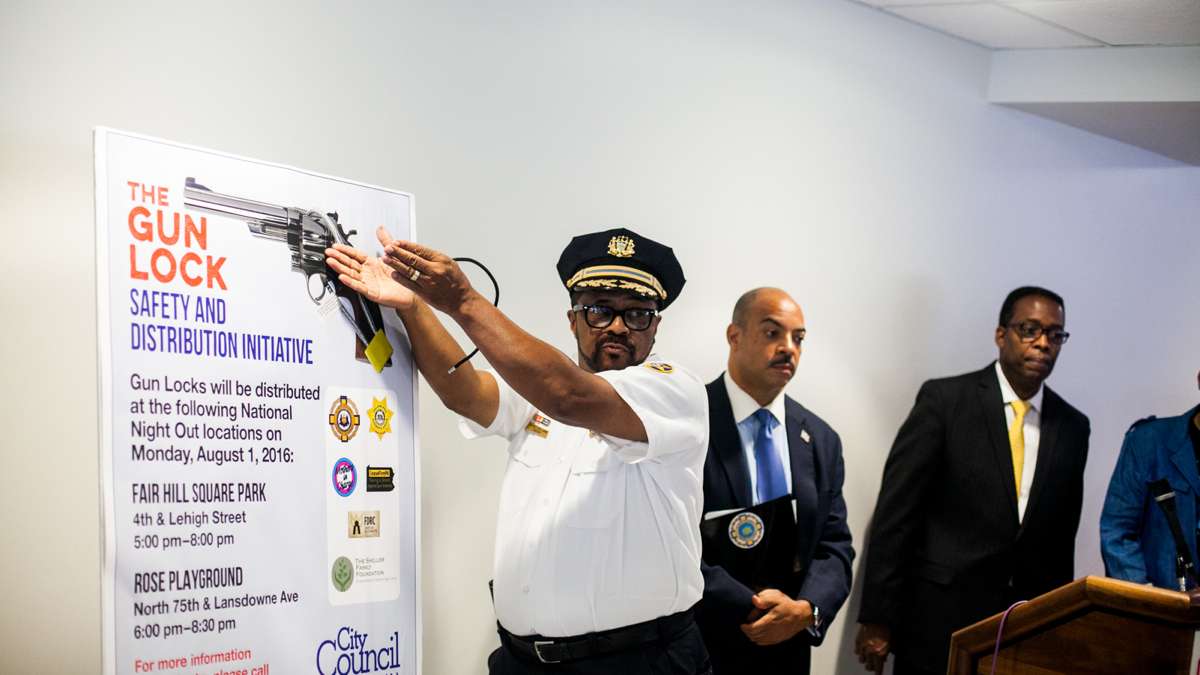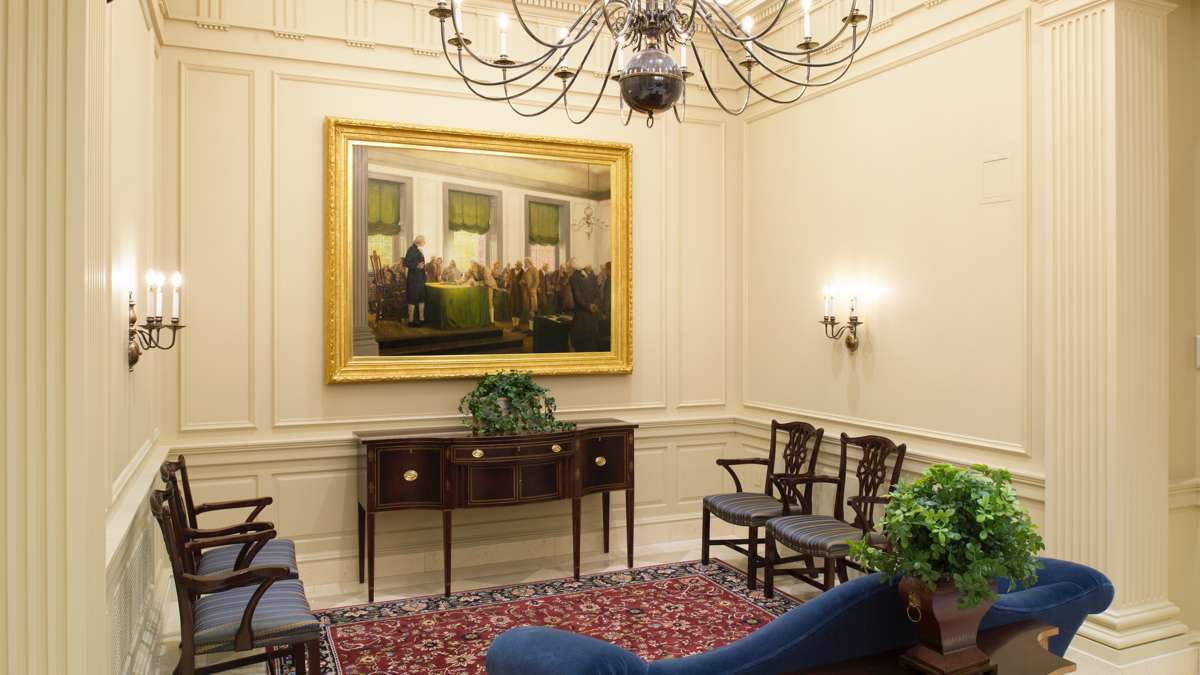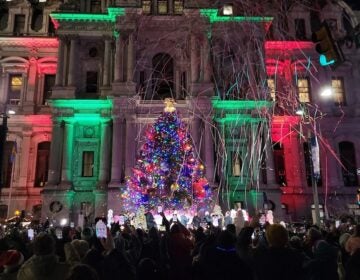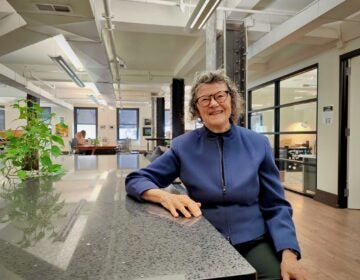Look of Mormon: Philadelphia temple offers glimpse into religious life of Latter-day Saints
ListenBeginning next week, the new Mormon temple in Philadelphia will be open to the public for a month, then it will be closed forever to anyone who is not a member of The Church of Jesus Christ of Latter-day Saints.
It has taken five years to build the temple at 17th and Vine streets, above I-676. A brick meeting hall for regular weekly services and celebrations has been built across the street. The 61,000-square-foot temple with soaring spires, to be dedicated on Sept. 18, is strictly for sacred ceremonies.
Normally, only card-carrying congregants in good standing are allowed inside. In the entrance lobby, where Mormons have those laminated cards checked, is a painting of the signing of the U.S. Constitution.
“This is a very unusual painting for an LDS temple,” said Larry Wilson, a senior church official who oversees temple development around the world. “Most of the paintings in our temples that depict historical events have to do with the life of Christ, or scenes from the Book of Mormon.”
Much of this temple’s design is inspired by America’s Founding Fathers — most prominently, the classic Georgian architecture often seen in grand historic buildings of the Colonial era. Of all the 152 temples built by LDS around the world, this is the only one with chandeliers, stair railings, door casings, and decorative trim hearkening back to that era.
“We believe the part of the reason for the founding of this country was to enable a faith such as ours to be established and grow and flourish the way it has,” said Wilson.
Equal in the sight of God
Past the front reception area, congregants immediately encounter locker room stalls. Visitors and administrative staff are required to don white clothing inside the temple (visitors during the open house period will be exempt). It’s meant to equalize all in the eyes of God.
Many people bring their own white clothes to change into on arrival; closets of white robes are available for those who do not.
The reasons for the rules and functions of the temple rooms reveal essential tenets of the Mormon faith. For example, while regular baptisms will not happen inside the temple — they will take place in the publicly accessible meeting hall across the street — the sacred temple has an elaborate baptismal pool built on the backs of 12 sculptural oxen. These are strictly for ancestors.
“All the baptisms in here are on behalf of deceased persons,” said Wilson. “We are encouraged to search out ancestors and perform ordinances for them so they might have the opportunity to accept that, if they choose.”
Members of the Church of Latter-day Saints — typically, teenagers — are brought under the water on behalf of those ancestors.
Ascending to the higher floors, the rooms become fancier, more costly. The first floor has tile floors and brass chandeliers. The second floor has hardwood floors and woven rugs, hallways trimmed in Doric columns. The third floor has crystal chandeliers and the columns are carved Corinthian.
The window glass panes are opaquely colored. No rumble from I-676 traffic can be heard. The climate-control system is remarkably resilient against the heat of summer. The walls are creamy with light reflected softly over plastered covering. The antique-style furnishings are all newly constructed.
“You feel removed from the world,” said Wilson. “Turn your heart and mind to God, toward deeper, more important things in life.”
The third floor has the Celestial Room, with soaring 40-foot domed ceilings and an enormous crystal chandelier. Furnished with upholstered settees, it resembles the lobby of a four-star hotel. It is the most grand room in the temple, reserved for prayer, meditation, and to seek heavenly guidance.
“Symbolically, they would be permitted into the presence of God,” said Wilson. “That’s what this room represents.”
Sealed for life and beyond
The fourth floor has four sealing rooms, where brides and grooms are married eternally, meaning they are bonded for this life and the afterlife.
Only Mormon wedding guests are allowed to see the sealing ceremony. Parents of the bride and groom who are not in the religious congregation are not allowed to attend.
Same-sex marriages are not allowed. Gay Mormons in civil marriages are not considered in good standing with the church; while they are allowed to congregate in the meeting halls, gay members are not allowed in the temple.
Divorce can be allowed with special permission from bishops. Widowed spouses can remarry “for time only,” meaning during their remaining time on Earth, not beyond.
Temples such as this are are the only places where formal LDS ceremonies can take place. The nearest temples to Philadelphia are in New York City and Washington, D.C. Families often have to travel great distances to participate in rites of passage.
Vai Sikahema, a sportscaster with NBC10 in Philadelphia, grew up Mormon in a thatch-roof hut on the island of Tonga, 1,500 miles from the nearest temple in New Zealand. In order to be sealed forever, his parents saved six years to buy one-way fare for themselves and their three kids. Sikahema was 5 years old.
“We traveled by boat from Tonga to Fiji — a day and a half. Spent a night there, then flew from Suva, Fiji, to Auckland, New Zealand, then a two-hour bus ride to Hamilton where the temple was,” said Sikahema. “My parents sold everything in order to come up with the fare.”
After the sealing ceremony, Sikahema remembers living with family in New Zealand while his father sheared sheep for three months to buy passage back home for himself and his family.
Now, he said, he tries to get down to the temple in Washington once a month, if he can. The Philadelphia temple makes it easier.
About 40,000 congregants in Southeast Pennsylvania, South Jersey, Delaware, and parts of Maryland are expected to use the Philadelphia temple.
WHYY is your source for fact-based, in-depth journalism and information. As a nonprofit organization, we rely on financial support from readers like you. Please give today.


























